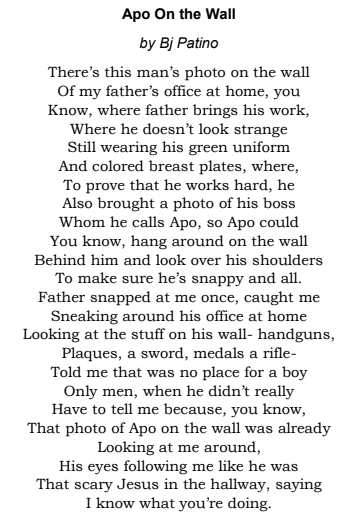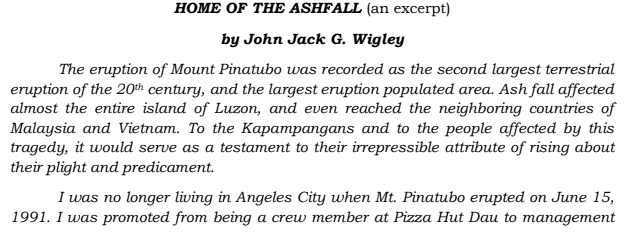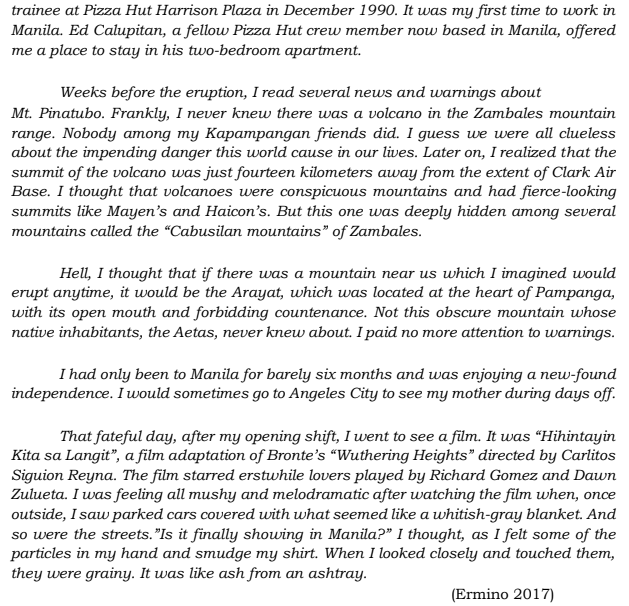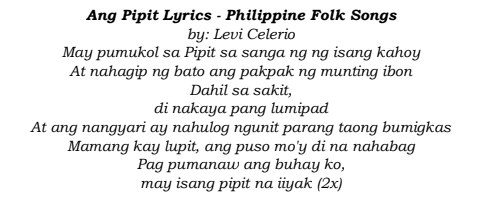
5 21st Century
Lesson 5 Multimedia Formats in Interpreting Literary Text
Marshall (2001) defined multimedia as computer-controlled integration of text, graphics, drawings, still and moving images (video), animation, audio, and any other media where every type of information can be represented, stored, transmitted and processed digitally. Here are some of the multimedia formats that you can use to creatively interpret various genres of literary texts.
Blog or a “weblog”: is a website containing informational articles about a person’s own opinions, interests and experiences. These are usually changed regularly (DepEd 2013, 9).
Mind mapping: is a graphical technique to visualize connections of ideas and pieces of information. This tool structures information to better analyze, comprehend, synthesize, recall and generate new ideas. You can use Microsoft Word or online mind mapping tools in creating a mind map (Pasuello 2017).
Mobile phone text tula: is a traditional Filipino poem. A particular example of this poem is a tanaga that consists of 4 lines with 7 syllables each with the same rhyme at the end of each line. (DepEd 2013, 8).
Slideshow presentation: is created with the use of Microsoft PowerPoint. It contains series of pictures or pages of information (slides) arranged in sequence and often displayed on a large screen using a video projector (Computer Hope 2018).
Tag cloud: is a visual, stylized arrangement of words or tags within a textual content such as websites, articles, speeches and databases (Techopedia 2020).
Video: is an electronic device used to record, copy, playback, broadcast, and display moving visual media (Lexico 2020).

Applying ICT Skills in Interpreting Literary Texts
An anecdote is a short entertaining or interesting story about a real incident or person (Nagpal 2016).
Anecdotes: tell about a variety of stories and tales, since they can be about any topic under the sun. It is a short story about a real person or event which usually intends to make the listeners laugh or ponder over a topic (Your Dictionary 2020).
Let’s explore some of the purposes of anecdotes:
To Bring Cheer: Stories pop up anywhere and these are just sometimes making people laugh to brighten their mood. Here is an example of an anecdote meant to look back on happy memories:
• At the dinner, a Grade 11 learner shared his story on his first day at school when he got lost and attended a wrong class.
To Reminisce: In most anecdotes, people are talking about their experiences in the past. They try to look back on moments in their lives and share the joy of that time with others. Here is an example of an anecdote with a hint of reminiscence:
• A mother tells her children a story about her life in the province when she was teenager.
To Caution: Sometimes, just giving rules for individuals is not effective. Sharing to them
frightening stories of dangers can be helpful for them to realize the possible consequences of their actions. Here is an example of cautionary anecdote:
• Before beginning a lecture on not following traffic rules, a father tells his son an incident of collision that caused many lives due to ignoring traffic signs.
To Persuade or Inspire: Sometimes, people share stories on how they surpassed their struggles in life. These, most of the time, give encouragement to others who have been in similar situations. The message usually conveys successes in life as a fruit of hard work. Here is an example of an inspirational anecdote:
• Before beginning a remedial class, the teacher tells the students how a boy who used to struggle in reading managed to be a proficient reader.



5 21st Century
Lesson 5 Multimedia Formats in Interpreting Literary Text
Marshall (2001) defined multimedia as computer-controlled integration of text, graphics, drawings, still and moving images (video), animation, audio, and any other media where every type of information can be represented, stored, transmitted and processed digitally. Here are some of the multimedia formats that you can use to creatively interpret various genres of literary texts.
Blog or a “weblog”: is a website containing informational articles about a person’s own opinions, interests and experiences. These are usually changed regularly (DepEd 2013, 9).
Mind mapping: is a graphical technique to visualize connections of ideas and pieces of information. This tool structures information to better analyze, comprehend, synthesize, recall and generate new ideas. You can use Microsoft Word or online mind mapping tools in creating a mind map (Pasuello 2017).
Mobile phone text tula: is a traditional Filipino poem. A particular example of this poem is a tanaga that consists of 4 lines with 7 syllables each with the same rhyme at the end of each line. (DepEd 2013, 8).
Slideshow presentation: is created with the use of Microsoft PowerPoint. It contains series of pictures or pages of information (slides) arranged in sequence and often displayed on a large screen using a video projector (Computer Hope 2018).
Tag cloud: is a visual, stylized arrangement of words or tags within a textual content such as websites, articles, speeches and databases (Techopedia 2020).
Video: is an electronic device used to record, copy, playback, broadcast, and display moving visual media (Lexico 2020).

Applying ICT Skills in Interpreting Literary Texts
An anecdote is a short entertaining or interesting story about a real incident or person (Nagpal 2016).
Anecdotes: tell about a variety of stories and tales, since they can be about any topic under the sun. It is a short story about a real person or event which usually intends to make the listeners laugh or ponder over a topic (Your Dictionary 2020).
Let’s explore some of the purposes of anecdotes:
To Bring Cheer: Stories pop up anywhere and these are just sometimes making people laugh to brighten their mood. Here is an example of an anecdote meant to look back on happy memories:
• At the dinner, a Grade 11 learner shared his story on his first day at school when he got lost and attended a wrong class.
To Reminisce: In most anecdotes, people are talking about their experiences in the past. They try to look back on moments in their lives and share the joy of that time with others. Here is an example of an anecdote with a hint of reminiscence:
• A mother tells her children a story about her life in the province when she was teenager.
To Caution: Sometimes, just giving rules for individuals is not effective. Sharing to them
frightening stories of dangers can be helpful for them to realize the possible consequences of their actions. Here is an example of cautionary anecdote:
• Before beginning a lecture on not following traffic rules, a father tells his son an incident of collision that caused many lives due to ignoring traffic signs.
To Persuade or Inspire: Sometimes, people share stories on how they surpassed their struggles in life. These, most of the time, give encouragement to others who have been in similar situations. The message usually conveys successes in life as a fruit of hard work. Here is an example of an inspirational anecdote:
• Before beginning a remedial class, the teacher tells the students how a boy who used to struggle in reading managed to be a proficient reader.



 Knowt
Knowt
